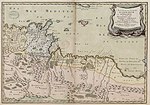| History of Tunisia |
|---|
 |
|
|
In its modern history, Tunisia is a sovereign republic, officially called the Republic of Tunisia. Tunisia has over ten million citizens, almost all of Arab-Berber descent. The Mediterranean Sea is to the north and east, Libya to the southeast, and Algeria to the west. Tunis is the capital and the largest city (over 800,000); it is located near the ancient site of the city of Carthage.[1][2]
Its first modern leader, President Habib Bourguiba brought to the office hard-won political experience, after many decades of service in the leadership of the independence movement. As the major figure of the Neo-Destour Party, he was instrumental in obtaining full independence for Tunisia in 1956. He dominated the government until his removal in 1987. During his years in office, his accomplishments included: a law reform, economic policies which detoured briefly in a socialist direction, a moderate but steady improvement in standard of living, and a foreign policy which retained an independent approach while maintaining trade and economic connections to the west.
Ben Ali became President of the Republic in 1987, and kept power until he was forced to leave in 2011. His economic policies emphasized a market orientation. His attempt at reapproachment with Islamist groups did not meet expectations. The ruling party was reorganized. Under his leadership Tunisia's economy continued to perform at a pace which yielded a moderate but overall steady rate of growth.
A Constituent Assembly was elected following the overthrow of Ben Ali, which completed the task of drafting a new constitution and handed over to newly elected authorities in 2014, ushering in the Second Republic.
- ^ See map at end of article.
- ^ For background information on geography, see History of Tunisia preview.